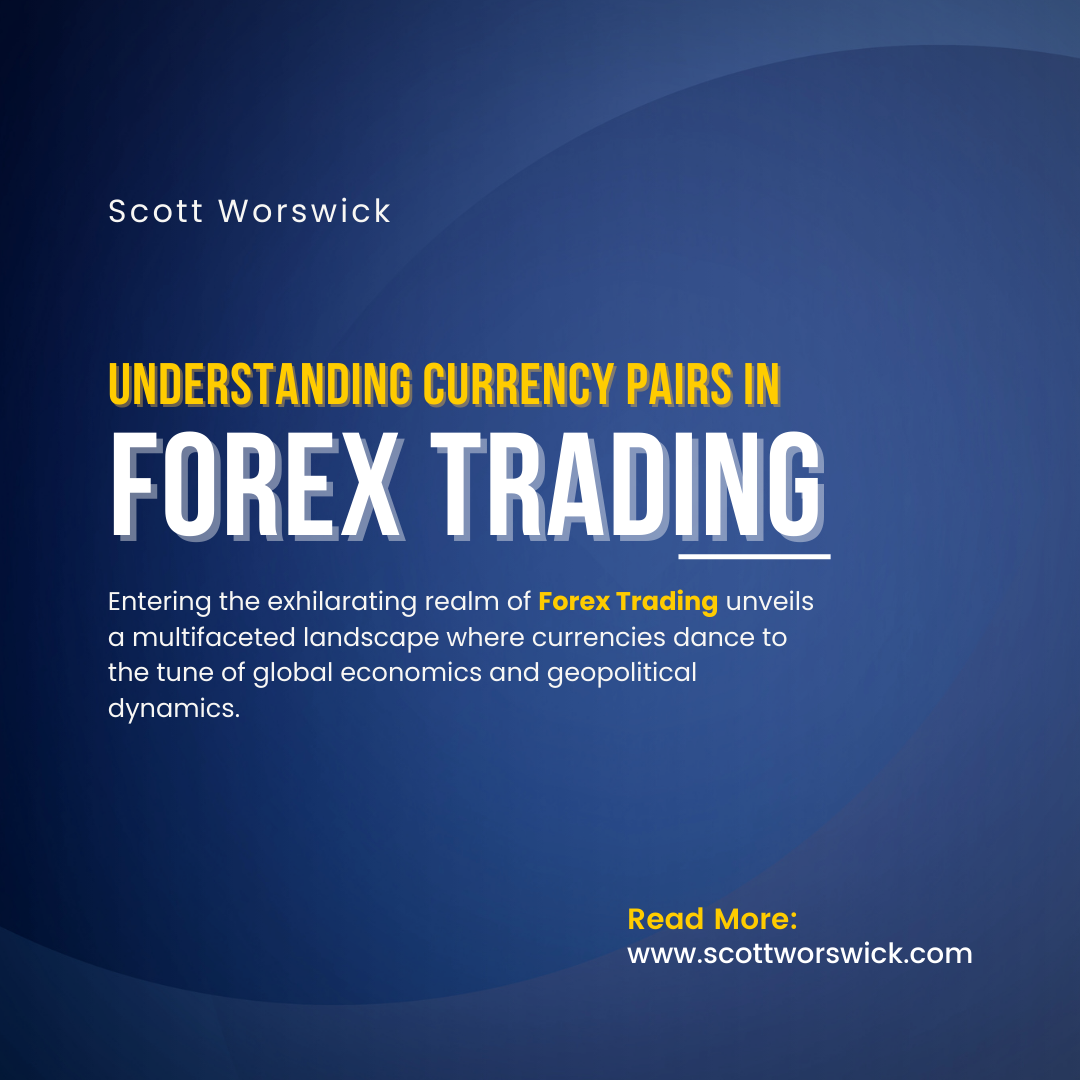Entering the exhilarating realm of Forex trading unveils a multifaceted landscape where currencies dance to the tune of global economics and geopolitical dynamics. Central to this intricate dance are currency pairs, the building blocks upon which Forex trading thrives. At its essence, understanding currency pairs is akin to deciphering a complex language, where each pair tells a unique story of the interplay between two distinct economies. These pairs serve as the compass guiding traders through the turbulent seas of the Forex market, enabling them to navigate fluctuations in exchange rates and seize profitable opportunities.
In the vast universe of Forex trading, currency pairs are the stars that illuminate the path to financial success. Each pair represents a delicate equilibrium between two currencies, reflecting their relative strength and value in the global marketplace. Whether it’s the widely traded majors like EUR/USD or the exotic pairs that offer a taste of adventure, each combination carries its own set of characteristics and risks. By delving into the intricacies of currency pairs, traders unlock a world of possibilities, where diligent analysis and strategic foresight pave the way to lucrative returns.
As traders delve deeper into the intricacies of currency pairs, they unveil the underlying forces that drive the Forex market’s heartbeat. Factors such as interest rates, economic indicators, geopolitical events, and market sentiment all converge to shape the dynamic landscape of currency exchange. Armed with this knowledge, traders can decode the signals embedded within currency pairs, discerning patterns and trends that guide their trading decisions. With a firm grasp of currency pair dynamics, traders harness the power of foresight, positioning themselves to capitalize on opportunities and navigate the ever-evolving currents of the Forex trading arena.
Table of Contents
1. What are Currency Pairs?
At the heart of forex trading lies the concept of currency pairs, the fundamental building blocks of the foreign exchange market. A currency pair is a representation of the relationship between two different currencies traded within the forex market. Each pair comprises a base currency and a quote currency, with their values relative to each other dictating the exchange rate. For instance, in the EUR/USD pair, the euro (EUR) serves as the base currency, while the US dollar (USD) functions as the quote currency. Understanding currency pairs is essential for navigating the dynamic landscape of forex trading, as they provide insights into the strengths, weaknesses, and fluctuations of various currencies.
Currency pairs in forex trading are categorized into three main types: major pairs, minor pairs, and exotic pairs. Major pairs consist of the most heavily traded currencies globally and typically involve currencies from leading economies such as the United States, Europe, and Japan. Examples include EUR/USD, GBP/USD, and USD/JPY. These pairs are characterized by high liquidity and relatively tight spreads, making them attractive options for both novice and seasoned traders. Minor pairs, on the other hand, do not include the US dollar and involve currencies from smaller economies or emerging markets. Examples include EUR/GBP, AUD/JPY, and GBP/CAD. While minor pairs may exhibit lower liquidity compared to majors, they still offer ample trading opportunities for those willing to explore beyond the mainstream. Exotic pairs encompass currencies from less developed or niche markets, often paired with a major currency. Examples include USD/TRY, USD/ZAR, and EUR/TRY. Exotic pairs tend to have wider spreads and higher volatility, presenting both increased risks and potential rewards for adventurous traders in the forex market.
In forex trading, understanding the notation used to represent currency pairs is paramount for effective communication and analysis. Currency pairs are denoted using a standardized format consisting of the base currency followed by the quote currency. For instance, the notation EUR/USD represents the euro against the US dollar, while USD/JPY represents the US dollar against the Japanese yen. This universal notation system enables traders worldwide to identify and trade currency pairs seamlessly across different platforms and markets. By mastering the intricacies of currency pairs and their notation, traders gain a deeper understanding of the forex market’s dynamics, empowering them to make informed decisions and capitalize on opportunities in their trading endeavors.
2. Major Currency Pairs in Forex Trading

In the realm of forex trading, major currency pairs stand as the bedrock of international currency exchange, embodying the essence of global economic powerhouses. These pairs consist of currencies from the world’s largest economies, facilitating the bulk of trading activity in the forex market. Among the most renowned major pairs is the EUR/USD, which represents the euro against the US dollar. As the most actively traded currency pair globally, the EUR/USD enjoys unparalleled liquidity and tight spreads, making it a favorite among traders seeking stability and reliability in their forex endeavors.
Another prominent major currency pair is the GBP/USD, which showcases the British pound sterling against the US dollar. Renowned for its volatility and responsiveness to economic and geopolitical developments, the GBP/USD offers traders ample opportunities for profit generation and risk management. Similarly, the USD/JPY pair, featuring the US dollar and the Japanese yen, holds a prominent position in the forex market due to the economic significance of both nations. As a barometer of global risk sentiment, the USD/JPY often reflects shifts in investor confidence and market sentiment, making it a valuable asset for traders seeking insights into broader market trends.
The major currency pairs in forex trading are not limited to those involving the US dollar. The USD/CHF pair, which pairs the US dollar with the Swiss franc, offers a unique perspective on currency dynamics, influenced by Switzerland’s reputation as a global financial hub and safe-haven currency. Additionally, the EUR/GBP pair, featuring the euro and the British pound sterling, provides insights into the interplay between two major European economies. As Brexit-related developments and economic data impact both currencies, the EUR/GBP remains a popular choice for traders seeking exposure to European markets without the direct influence of the US dollar.
In summary, major currency pairs serve as the cornerstone of forex trading, embodying the economic prowess and global influence of leading nations. Whether it’s the EUR/USD, GBP/USD, USD/JPY, or USD/CHF, these pairs offer traders unparalleled liquidity, volatility, and opportunity for profit generation. By understanding the intricacies of major currency pairs and their underlying economic fundamentals, traders can navigate the dynamic forex market with confidence, harnessing the potential for success in their trading endeavors.
3. Minor Currency Pairs
In the expansive landscape of forex trading, minor currency pairs emerge as the hidden gems, offering traders unique opportunities for diversification and profit generation. These pairs, also known as cross currency pairs, exclude the US dollar from their composition, featuring currencies from smaller economies or emerging markets. While they may not attract the same level of attention as major pairs, minor currency pairs play a crucial role in providing insights into global economic trends and geopolitical developments.
One notable example of a minor currency pair is the EUR/GBP, which represents the euro against the British pound sterling. Despite its “minor” classification, the EUR/GBP holds significant relevance for traders seeking exposure to European markets and Brexit-related developments. As economic data and political events impact both currencies, the EUR/GBP offers valuable insights into the intricacies of European monetary policy and market sentiment.
Another prominent minor currency pair is the AUD/JPY, featuring the Australian dollar and the Japanese yen. As two major currencies in the Asia-Pacific region, the AUD/JPY reflects shifts in commodity prices, interest rates, and risk sentiment, making it a favorite among traders seeking exposure to Asian markets. With Australia’s close ties to commodity exports and Japan’s role as a global manufacturing hub, the AUD/JPY serves as a barometer of economic activity in the region, providing traders with valuable signals for their forex trading strategies.
In summary, minor currency pairs enrich the tapestry of forex trading, offering traders a diverse array of options beyond the confines of major pairs. Whether it’s the EUR/GBP, AUD/JPY, or other cross-currency pairs, these instruments provide unique insights into regional economic dynamics and geopolitical events. By understanding the nuances of minor currency pairs and their underlying fundamentals, traders can broaden their horizons and seize opportunities in the dynamic world of forex trading.
4. Exotic Currency Pairs

In the diverse and intricate realm of forex trading, exotic currency pairs emerge as the captivating outliers, offering traders a taste of adventure and the potential for substantial rewards. These pairs, characterized by their inclusion of currencies from smaller or less developed economies, often paired with a major currency, provide a unique avenue for diversification and speculation in the forex market. While they may carry higher volatility and wider spreads compared to major and minor pairs, exotic currency pairs appeal to traders drawn to the allure of untapped potential and the opportunity to capitalize on emerging market trends.
One notable example of an exotic currency pair is the USD/TRY, featuring the US dollar and the Turkish lira. As Turkey’s currency undergoes fluctuations driven by domestic economic conditions and geopolitical factors, the USD/TRY offers traders a lens through which to analyze the country’s economic stability and political landscape. With Turkey’s strategic location bridging Europe and Asia and its growing influence in the region, the USD/TRY provides valuable insights for traders seeking exposure to emerging markets and geopolitical developments.
Another intriguing exotic currency pair is the USD/ZAR, pairing the US dollar with the South African rand. South Africa’s rich natural resources, diverse economy, and unique geopolitical challenges contribute to the volatility and unpredictability of the USD/ZAR pair. Traders navigating this exotic pair must contend with factors such as commodity prices, political developments, and economic reforms, making it an exciting yet challenging instrument in the forex market. By understanding the intricacies of the USD/ZAR and its underlying fundamentals, traders can uncover opportunities amidst the volatility and uncertainty inherent in exotic currency pairs.
In summary, exotic currency pairs add an element of excitement and opportunity to forex trading, offering traders a window into the complexities of emerging markets and geopolitical dynamics. Whether it’s the USD/TRY, USD/ZAR, or other exotic pairs, these instruments provide a platform for speculation, diversification, and strategic maneuvering in the ever-evolving landscape of the forex market. By embracing the challenges and opportunities presented by exotic currency pairs, traders can expand their horizons and unlock new avenues for success in their trading endeavors.
5. Understanding Currency Pair Notation
In the dynamic world of forex trading, mastering currency pair notation is akin to learning the language of the market, enabling traders to effectively communicate and analyze trading opportunities. Currency pair notation follows a standardized format, with each pair denoted by a combination of letters representing the base and quote currencies. For instance, in the EUR/USD pair, “EUR” stands for the euro, which serves as the base currency, while “USD” represents the US dollar, the quote currency. Understanding this notation is essential for traders to identify and trade currency pairs seamlessly across various platforms and markets, ensuring clarity and consistency in their trading endeavors.
The notation used to represent currency pairs in forex trading serves as a universal language that transcends geographical and linguistic barriers, facilitating efficient communication among traders worldwide. Whether based in New York, Tokyo, or London, traders can easily interpret currency pair symbols and understand the underlying currencies involved. This universal notation system fosters transparency and accessibility in the forex market, empowering traders to participate in global currency exchange with confidence and ease.
By familiarizing themselves with currency pair notation, traders gain valuable insights into the dynamics of the forex market and the relationships between different currencies. Each currency pair symbolizes a unique combination of economic fundamentals, geopolitical factors, and market sentiment, influencing exchange rates and price movements. Whether trading major pairs like EUR/USD or exotic pairs such as USD/TRY, understanding the notation allows traders to decipher these complexities and make informed decisions in their forex trading activities.
In summary, currency pair notation serves as a cornerstone of forex trading, providing traders with a standardized framework for identifying, analyzing, and trading currency pairs. By mastering the language of currency pairs, traders gain a deeper understanding of the market dynamics and unlock opportunities for profit generation and risk management. Whether navigating major, minor, or exotic pairs, proficiency in currency pair notation empowers traders to navigate the ever-evolving landscape of the forex market with confidence and precision.
Conclusion
In conclusion, a solid grasp of currency pairs is indispensable for success in forex trading, serving as the compass that guides traders through the complexities of the market. By understanding the relationships between different currencies and the factors influencing their values, traders can make informed decisions and navigate fluctuations in exchange rates with confidence. Whether trading major, minor, or exotic pairs, the ability to analyze currency pair dynamics empowers traders to capitalize on opportunities and manage risks effectively in the dynamic world of forex trading.
Furthermore, mastering currency pair notation is essential for effective communication and analysis in forex trading. By familiarizing themselves with the standardized notation system, traders can easily identify and interpret currency pair symbols, facilitating seamless transactions and collaboration across global markets. This universal language transcends geographical and linguistic barriers, fostering transparency and accessibility in the forex market and enabling traders to participate in currency exchange with clarity and precision.
Ultimately, understanding currency pairs lays the foundation for success in forex trading, providing traders with the knowledge and tools needed to navigate the ever-changing landscape of the market. Whether it’s major pairs like EUR/USD, minor pairs such as EUR/GBP, or exotic pairs like USD/TRY, each currency pair tells a unique story of economic fundamentals, geopolitical dynamics, and market sentiment. By honing their understanding of currency pairs, traders can unlock opportunities for profit generation and position themselves for success in their forex trading endeavors.





Pingback: Exploring Forex Trading Platforms: A Comprehensive Guide to Choosing the Right One -
I love how this blog gives a voice to important social and political issues It’s important to use your platform for good, and you do that flawlessly
The depth you bring to The topics is like diving into a deep pool, refreshing and invigorating.
The words are like seeds, planting ideas that blossom into understanding and appreciation.
A refreshing take on the subject, like a cool breeze on a hot day. I’m all ears for what you have to say next.